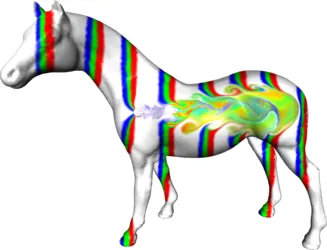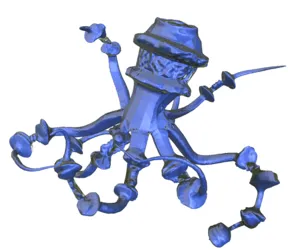Real-Time Fluid Effects on Surfaces using the Closest Point Method
Stefan Auer*, Colin B. Macdonald+, Marc Treib*, Jens Schneider#, Rüdiger Westermann*
* Computer Graphics and Visualization Group, Technische Universität München, Germany
+ Oxford Centre for Collaborative Applied Mathematics, Oxford University, United Kingdom
# Geometric Modeling and Scientific Visualization Center, King Abdullah University of Science and Technology, Saudi Arabia


Background
The Closest Point Method (CPM) is a method for numerically solving partial differential equations (PDEs) on arbitrary surfaces, independent of the existence of a surface parametrization. The CPM uses a closest point representation of the surface, to solve the unmodified Cartesian version of a surface PDE in a 3D volume embedding, using simple and well-understood techniques. In this paper we present the numerical solution of the wave equation and the incompressible Navier-Stokes equations on surfaces via the CPM, and we demonstrate surface appearance and shape variations in real-time using this method. To fully exploit the potential of the CPM, we present a novel GPU realization of the entire CPM pipeline. We propose a surface-embedding adaptive 3D spatial grid for efficient representation of the surface, and present a high-performance approach using CUDA for converting surfaces given by triangulations into this representation. For real-time performance, CUDA is also used for the numerical procedures of the CPM. For rendering the surface (and the PDE solution) directly from the closest point representation without the need to reconstruct a triangulated surface, we present a GPU ray-casting method that works on the adaptive 3D grid.
Acknowledgments
This publication was based on work supported in part by the Munich Centre of Advanced Computing at the Technische Universität München (TUM) and by Awards No. KUK-C1-013-04 and UK-C0020, made by King Abdullah University of Science and Technology (KAUST).
Associated publications
Real-Time Fluid Effects on Surfaces using the Closest Point Method (author's postprint)
S. Auer, C.B. Macdonald, M. Treib, J. Schneider, R. Westermann, Computer Graphics Forum 31, 6 (2012), 1909–1923. The definite version can be found at Wiley.com